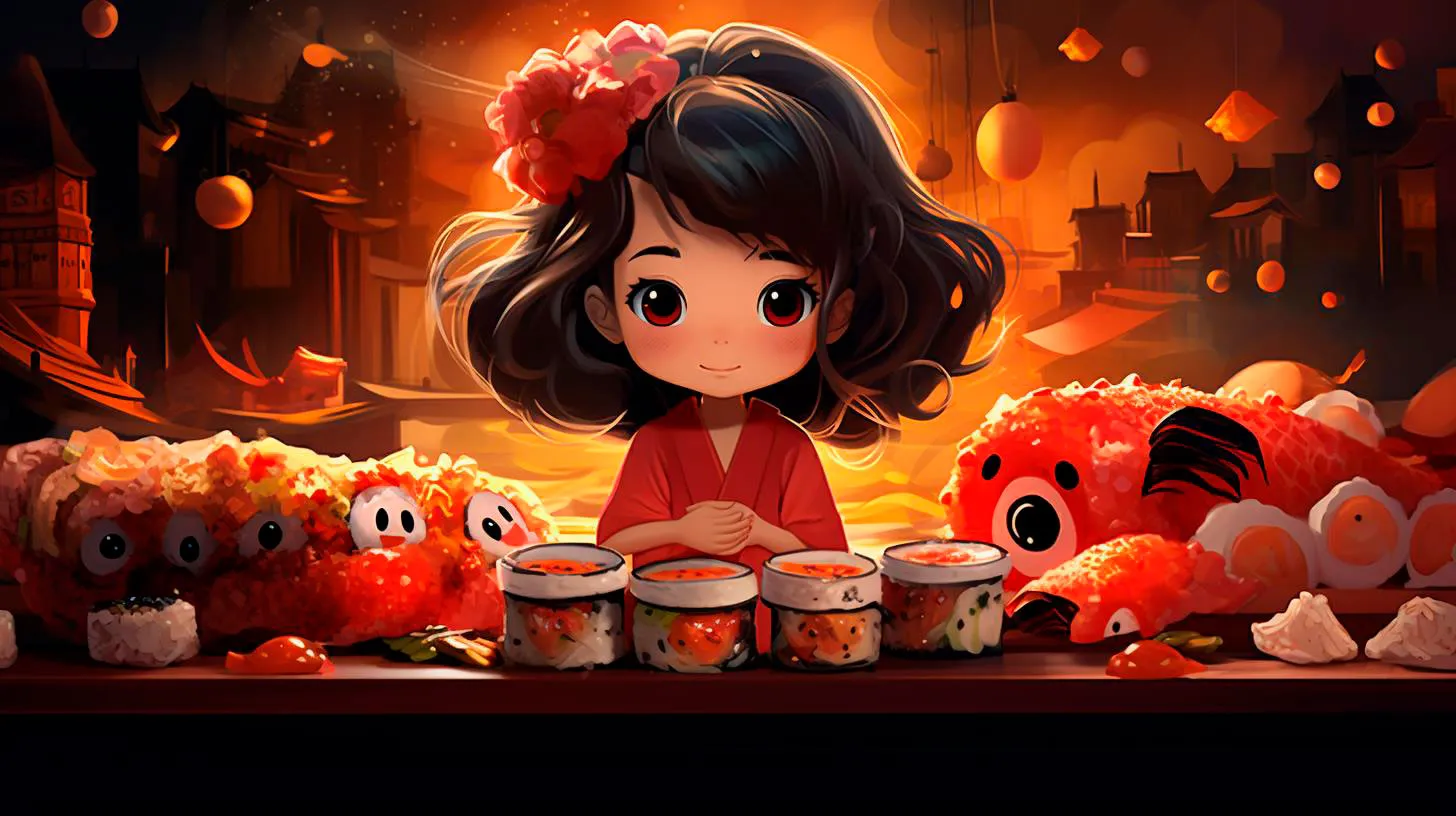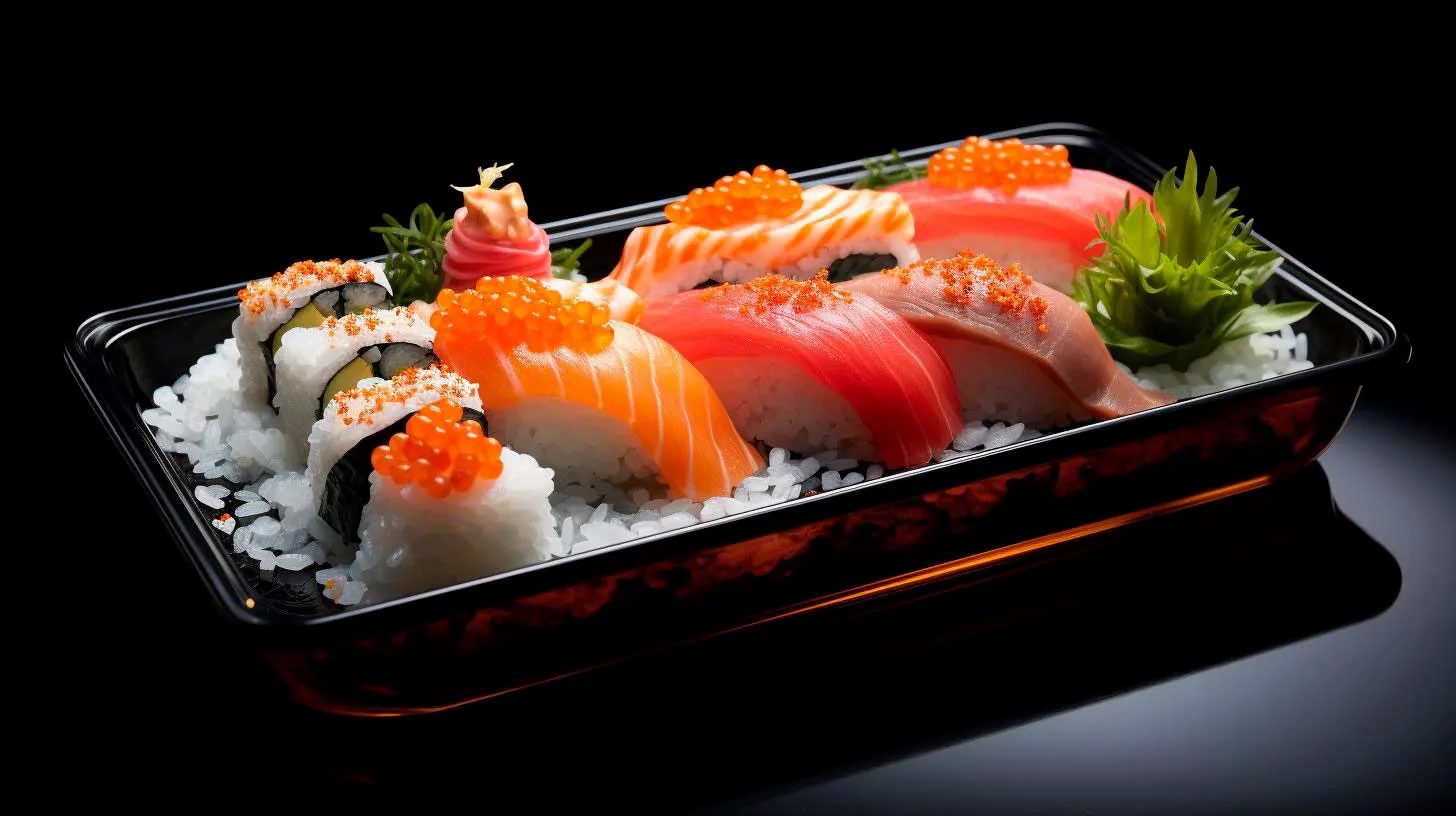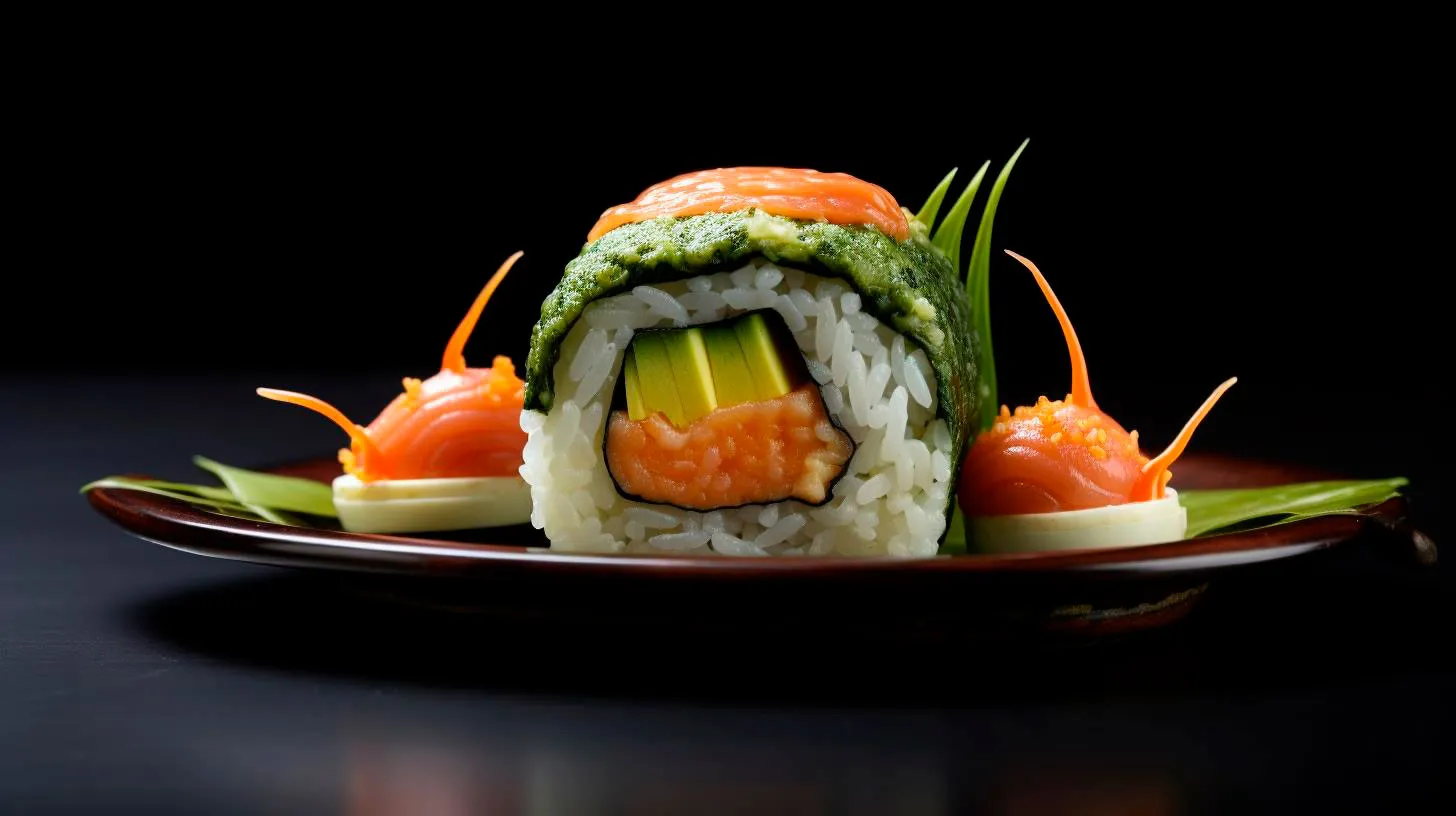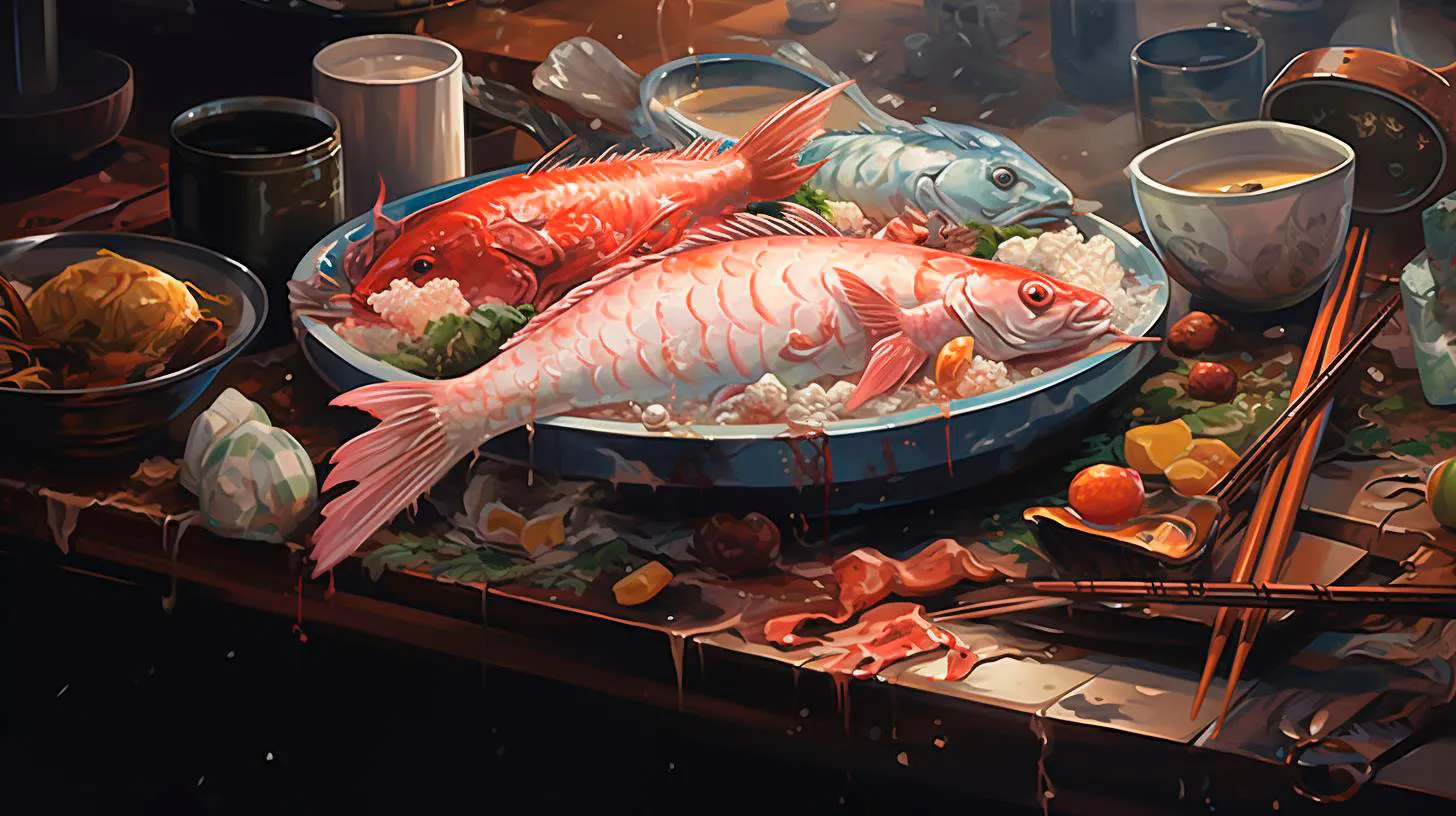Culinary Folklore: Exploring the Mythical Origins of Michelin-Starred Sushi Restaurants
Join us on a journey through time and legends as we unveil the secrets behind this culinary phenomenon.
The Mythical Origins of Sushi
Sushi, the iconic Japanese dish that has captivated the world’s palate, can be traced back to ancient times. However, its exact origins remain shrouded in mystery and surrounded by mythical stories. One of the most popular folklore tales is centered around Hanaya Yohei, a sushi chef from the early 19th century. Legend has it that he was the one who revolutionized sushi by introducing the nigiri style that we know today.
According to the tale, Hanaya Yohei realized that placing sashimi (raw fish slices) on top of rice provided a perfect blend of flavors. This innovation made sushi more accessible and enjoyable for everyone. Hanaya’s nigiri technique quickly gained popularity and eventually led to the development of sushi as an art form.
While the story of Hanaya Yohei is undoubtedly captivating, it is crucial to acknowledge that sushi existed before his time. The true origins of sushi can be traced back further, with ancient records showing that fish preserved in fermented rice was consumed in Southeast Asia more than 2,000 years ago. This technique was gradually refined and evolved into what we know as sushi today.
The Rise of the Michelin Stars
Fast forward to the early 20th century, when the Michelin Guide emerged as the ultimate authority in the culinary world. Developed by the Michelin tire company as a means to encourage road travel and increase tire sales, this guide bestowed coveted stars upon exceptional dining establishments. Originally focused on France, the guide’s influence expanded globally, bringing with it new yardsticks for culinary excellence.
In 2007, the Michelin Guide turned its attention to Japan, a country renowned for its gastronomic heritage. The inaugural edition featured Tokyo, Osaka, and Kyoto, setting the stage for sushi restaurants to shine on an international scale. Suddenly, the world witnessed an unprecedented surge in Michelin-starred sushi restaurants, captivating food enthusiasts and creating a new benchmark for culinary perfection.
Key Takeaways for Michelin-Starred Sushi Restaurants:
- Maintain the highest quality standards: The pursuit of excellence in every aspect of sushi preparation and presentation is of utmost importance.
- Embrace traditional techniques: Honoring the rich history and traditions of sushi-making helps to preserve the authenticity and uniqueness of the craft.
- Source the freshest ingredients: Utilizing premium, sustainably sourced fish and other ingredients ensures a remarkable dining experience.
- Impeccable attention to detail: Presentation, texture, and flavor must harmoniously come together, showcasing the chef’s expertise and creativity.
- Continual innovation: While respecting traditions, Michelin-starred sushi restaurants also explore new flavor combinations and techniques to push the boundaries of culinary artistry.
The Influence of Michelin Stars on Sushi Restaurants
The impact of Michelin stars on sushi restaurants cannot be overstated. As the world’s most respected culinary distinction, earning even a single Michelin star can catapult a sushi restaurant into a league of its own. It opens doors to international recognition, attracts discerning diners, and establishes a reputation for unparalleled excellence.
In addition to increased prestige, Michelin stars often lead to a surge in reservations and customers, resulting in higher revenues. A study conducted in 2019 found that Michelin-starred restaurants in Japan experienced a 30% increase in reservation requests after receiving the esteemed honor. This surge demonstrates the power of the Michelin Guide in driving food tourism and creating highly sought-after culinary destinations.
Advantages of Achieving Michelin Stars:
- Global acclaim and recognition: Michelin stars put sushi restaurants on the world map, attracting food enthusiasts and critics from all corners of the globe.
- Increased customer trust: The Michelin seal of approval instills confidence in diners, assuring them of a remarkable culinary experience.
- Expanded business opportunities: Michelin-starred sushi restaurants often receive invitations to collaborate on international events, fostering networking and collaboration opportunities.
- Attracting top talent: Talented chefs aspire to work in Michelin-starred establishments, fostering a culture of innovation and creativity.
- Positive impact on local economy: Michelin stars create a ripple effect that benefits not only the restaurant but also the local food industry and tourism sector.
Today, Michelin-starred sushi restaurants continue to enchant both connoisseurs and adventurers, offering an extraordinary experience that blends culinary artistry, tradition, and innovation.
As sushi remains an integral part of global gastronomy, the mythical origins and influence of Michelin stars on this culinary delight will forever be celebrated. So, next time you savor a piece of perfectly crafted sushi, ponder the centuries of history and legends that brought it to your plate.
Secrets of Perfection: Unveiling the Legends of Michelin-Starred Sushi Restaurants
These legendary establishments have earned their Michelin stars through unparalleled skill, creativity, and dedication, setting the bar for sushi excellence. In this article, we delve into the secrets behind the perfection of Michelin-starred sushi restaurants and the legends they have become.
The Pursuit of Culinary Excellence
Michelin-starred sushi restaurants are renowned for their unwavering commitment to culinary excellence. Every aspect of the dining experience is carefully curated to leave an indelible impression on the guests. These establishments take immense pride in sourcing the finest ingredients, adhering to time-honored techniques, and showcasing the artistry of sushi-making.
Key Takeaway: Pursuing perfection requires attention to detail, selecting the best ingredients, and showcasing artisanal skills.
The Art of Sourcing Ingredients
Sourcing top-quality ingredients is a critical factor that sets Michelin-starred sushi restaurants apart. Sushi chefs meticulously select fish and seafood from sustainable sources, often relying on local suppliers and fish markets. The emphasis on freshness and seasonality ensures that each piece of sushi bursts with flavor and texture.
Furthermore, Michelin-starred sushi restaurants often venture beyond the seas to showcase the diversity of flavors. Exotic ingredients such as uni (sea urchin), toro (fatty tuna), and ikura (salmon roe) are meticulously sourced to provide a unique and memorable dining experience.
Key Takeaway: The use of high-quality, sustainably sourced ingredients elevates the flavor profiles of sushi.
The Masterful Craftsmanship
Behind the sushi counter, a master chef with years of training honed to perfection stands. These skilled artisans have devoted their lives to perfecting the art of sushi-making. From the delicate slicing of the fish to the precision of rice molding, every step is executed with surgical precision and unwavering attention to detail.
It can take years, if not decades, for a sushi chef to master the techniques necessary to create a truly exceptional sushi experience. Their hands move with grace and skill, ensuring that each piece of sushi is a culinary masterpiece that reflects their dedication and expertise.
Key Takeaway: The craftsmanship and expertise of sushi chefs contribute to the extraordinary quality of Michelin-starred sushi restaurants.
The Omakase Experience
A hallmark of Michelin-starred sushi restaurants is the omakase dining experience. Rather than selecting dishes from a menu, customers entrust their palate to the seasoned expertise of the chef. This allows the chef to create a personalized tasting menu, showcasing their skills and creativity while considering individual preferences and dietary restrictions.
The omakase experience is a journey through different flavors, textures, and presentations, offering a tantalizing experience that evolves with each course. It fosters a deep sense of trust between the chef and the guest, creating a unique and intimate dining experience.
Key Takeaway: The omakase experience highlights the culinary expertise of the chef and provides a personalized and exceptional sushi adventure.
The Iconic Michelin Star
Earning Michelin stars is the ultimate recognition of culinary excellence. A Michelin star is awarded to restaurants that consistently deliver exceptional quality, creativity, and service. For sushi restaurants, this recognition signifies a commitment to perfection, as judged by esteemed critics and experts.
Michelin-starred sushi restaurants are a rare breed, with only a select few obtaining this prestigious accolade. It is a testament to the skill, passion, and dedication of the chefs, elevating them to legendary status within the culinary world.
Key Takeaway: Michelin stars represent the highest form of recognition for sushi restaurants, signifying their commitment to excellence.
Michelin-starred sushi restaurants blend tradition with innovation, creating an unforgettable experience for sushi lovers. They offer a glimpse into the secret world of sushi mastery, showcasing the pinnacle of culinary artistry. From the careful selection of ingredients to the craftsmanship of the chefs, each element plays a vital role in creating an extraordinary dining experience.
Unveiling the legends of Michelin-starred sushi restaurants reveals not only the dedication and passion of the chefs but also the secrets behind their quest for perfection. As the pursuit of culinary excellence continues, these legends will inspire future generations, ensuring the legacy of exquisite sushi lives on.
Exquisite Traditions: The Fascinating Stories Hiding behind Michelin-Starred Sushi Restaurants
In this article, we dive deep into the fascinating world of Michelin-starred sushi restaurants and uncover the hidden tales that make them truly exceptional.
Embracing Centuries of Tradition
Sushi is more than just a meal; it is an art form that has been passed down through generations. The art of sushi-making can be traced back to the 8th century in Japan when it was first mentioned in historical records. Over the centuries, sushi has evolved, with different regions in Japan developing their own unique styles and techniques.
- Key Takeaway: Sushi is not merely a culinary delight but a representation of cultural heritage and tradition.
The Journey to Perfection
Making sushi is an intricate craft that demands utmost precision and attention to detail. It takes years of practice and dedication to master the art of sushi-making. The chefs who achieve Michelin-starred status have spent countless hours perfecting their skills, ensuring each piece of sushi is flawlessly executed.
These talented chefs meticulously source the freshest and highest quality ingredients, often forging strong relationships with local fishermen and farmers. From the selection of fish and rice to the delicate process of slicing and molding, every step is carefully crafted to create a symphony of flavors.
- Feature: Michelin-starred sushi restaurants boast exceptional attention to detail, utilizing only the finest ingredients masterfully prepared by skilled chefs.
- Advantage: Guests can expect an unparalleled dining experience, where every bite is a masterpiece.
Preservation of Traditional Techniques
While sushi has become increasingly popular worldwide, many traditional sushi chefs remain committed to preserving their ancestral techniques. These master craftsmen pass down their knowledge to the next generation, ensuring that the art of sushi-making remains true to its roots.
At Michelin-starred sushi restaurants, the chefs honor the time-honored techniques while embracing innovation and creativity. They blend the old and the new, infusing traditional flavors with modern elements, resulting in a harmonious balance that keeps the tradition alive while captivating contemporary taste buds.
- Feature: Michelin-starred sushi restaurants combine tradition and innovation, creating a unique dining experience that respects the past while embracing the future.
A Glimpse into History
Each Michelin-starred sushi restaurant has a story to tell, woven with the rich tapestry of history. From humble beginnings to international acclaim, these establishments have stood the test of time, upholding the principles of excellence and uncompromising quality.
For example, Sukiyabashi Jiro, a three-Michelin-starred sushi restaurant in Tokyo, has a legacy spanning over 50 years. Its legendary chef, Jiro Ono, is considered a national treasure in Japan. The restaurant’s dedication to perfection and adherence to traditional techniques have earned it global recognition.
- Feature: Michelin-starred sushi restaurants often have a long-standing history, with legendary chefs and established legacies.
- Advantage: Dining at these renowned establishments offers a glimpse into the rich culinary history of sushi.
Conclusion
Michelin-starred sushi restaurants are not simply places to savor delectable meals; they are gateways to a world of remarkable traditions and stories. Through the careful craftsmanship of skilled chefs, coupled with the preservation of centuries-old techniques, these establishments transport diners to a realm where time-honored traditions meet modern innovation.
Next time you indulge in a sumptuous plate of sushi at a Michelin-starred restaurant, take a moment to appreciate the artistry and cultural heritage behind each bite. Let yourself be captivated by the fascinating stories hiding behind those unassuming doors, and savor the exquisite traditions that make these dining experiences truly exceptional.
Legendary Sushi Masters: The Unforgettable Tales behind Michelin-Starred Sushi Restaurants
Join us on a journey as we explore their unforgettable tales and the remarkable sushi restaurants they have built.
The Art of Sushi Mastery
Mastering the art of sushi requires years, if not decades, of painstaking practice and dedication. It is a transformative journey where sushi chefs perfect their skills, constantly pushing the boundaries of the traditional sushi-making process. Their pursuit is not only to create a mouth-watering sushi experience but also to leave a lasting impression on their patrons.
Key Takeaway: The art of sushi mastery goes beyond making delicious sushi—it is a blend of skill, passion, and innovation.
The Secrets Behind Michelin-Starred Sushi Restaurants
Michelin stars serve as the ultimate recognition for culinary excellence. To earn Michelin stars, sushi masters must demonstrate extraordinary technical skills, exceptional flavors, and impeccable attention to detail. The dedication of these sushi masters to their craft is reflective of the outstanding dining experiences they offer to their guests.
Key Takeaway: Michelin-starred sushi restaurants stand apart due to their exceptional attention to technical skills, flavors, and overall dining experience.
The Unforgettable Tales of Legendary Sushi Masters
1. Jiro Ono: Renowned as the world’s greatest sushi chef, Jiro Ono is the owner of Sukiyabashi Jiro in Tokyo. Featured in the critically acclaimed documentary “Jiro Dreams of Sushi,” his sushi restaurant has earned three Michelin stars. Jiro’s passion for perfection and unwavering dedication to his craft have made him the epitome of a legendary sushi master.
- Jiro’s sushi restaurant has only ten seats, ensuring an intimate dining experience.
- His use of the freshest ingredients and precise techniques creates sushi that melts in your mouth.
- Jiro’s relentless pursuit of perfection has influenced sushi chefs worldwide.
2. Masayoshi Takayama: Known as Chef Masa, Masayoshi Takayama is the visionary behind New York City’s three Michelin-starred restaurant Masa. Chef Masa’s inventive combination of traditional and modern techniques has revolutionized the sushi scene, earning him a dedicated following among food enthusiasts.
- Masa offers an extraordinary omakase experience, where the chef curates a personalized menu tailored to each guest’s preferences.
- Chef Masa’s attention to detail ensures that every ingredient used in his sushi is of the highest quality.
- With a limited number of seats, Masa provides an exclusive and unforgettable dining adventure.
3. Jiro’s apprentice, Daisuke Nakazawa: Trained under the legendary Jiro Ono, Daisuke Nakazawa has made his mark in the sushi world with his restaurant Sushi Nakazawa in New York City. With one Michelin star, Nakazawa’s meticulous approach to sushi-making and his ability to infuse subtle flavors into each bite have won him critical acclaim.
- Nakazawa’s omakase menu showcases a variety of seasonal ingredients and presents sushi in a creative yet traditional manner.
- His dedication to perfection can be seen in the fish, which he personally selects each morning from the fish market.
- Nakazawa’s signature dish, “Shiro-zu,” brilliantly marries flavors inspired by his time at Sukiyabashi Jiro.
Key Takeaway: Legendary sushi masters like Jiro Ono, Masayoshi Takayama, and Daisuke Nakazawa have shaped the sushi industry with their unrelenting pursuit of excellence and groundbreaking techniques.
In Conclusion
Legendary sushi masters have not only elevated sushi to an esteemed art form but have also left an indelible mark on the culinary world. Their relentless pursuit of perfection, innovative techniques, and dedication to sourcing the freshest ingredients have earned them well-deserved Michelin stars and an enduring place in the hearts of sushi enthusiasts worldwide. The unforgettable tales behind these Michelin-starred sushi restaurants will continue to inspire aspiring sushi chefs and captivate the taste buds of sushi lovers.



